
The Blessed Virgin Mary

venerated in the Order of Malta as
Throughout our Order, the birthday of Our Lady is kept with great solemnity in thanksgiving for the raising of the Turkish siege of Malta on 8 September 1565. At Valletta, in the Order's church of St. John the Baptist, there was venerated an ancient icon of Our Lady which had originally been brought from Jerusalem to the shrine on Mount Phileremos on Rhodes (hence the title). An exact copy is now one of the treasures of the Basilica of St. Mary of the Angels at Assisi.
This feast, which traces the privileges of Our Lady to Christ her son, was introduced by Pope Sergius I (687-701), following Eastern tradition. Our Lady's Birthday is closely linked with the coming of the Messiah: it is the promise, the preparation and the fruit of salvation. Mary was the dawn before the Sun of Justice and the herald to all the world of the joy brought by our Saviour.
[From: The Missal with readings of the Order of St. John of Jerusalem of Rhodes, & of Malta, London 1997]
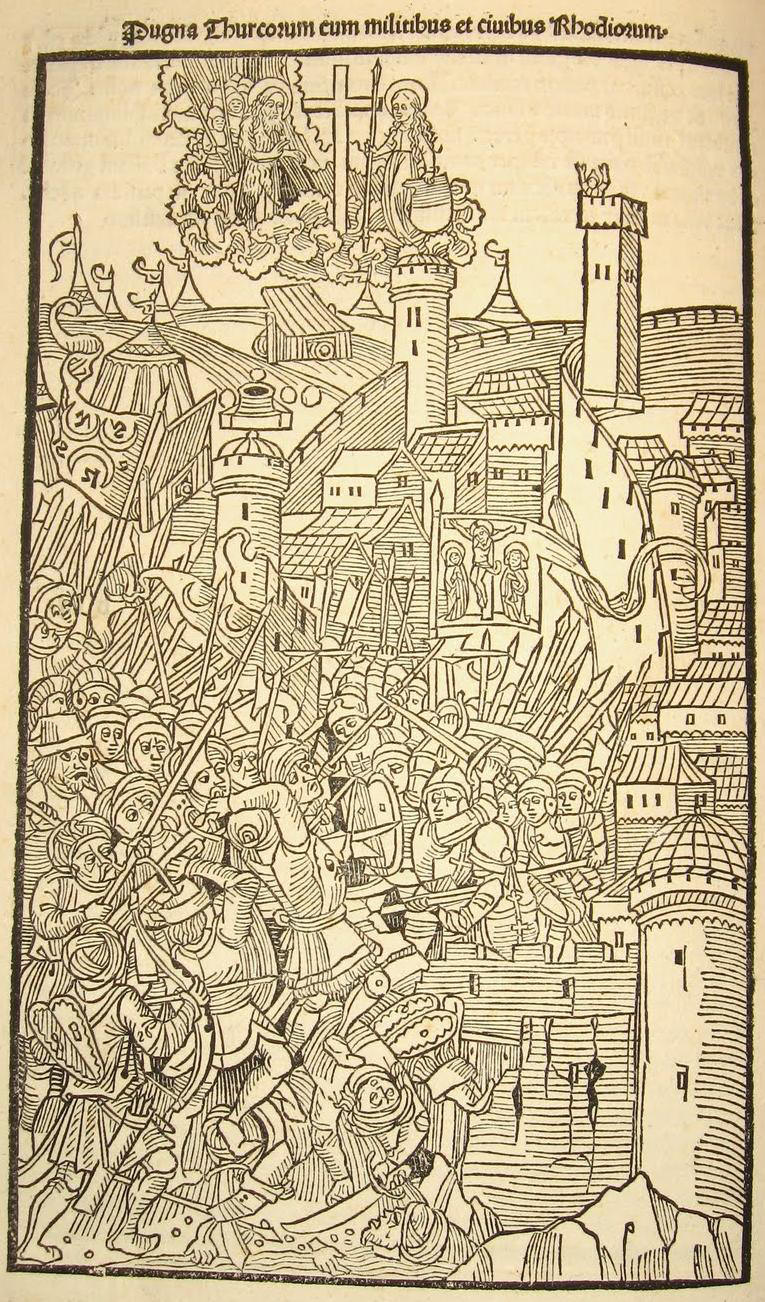 Vision of the shining virgin
Vision of the shining virgin The story went that the Turks were terrified by a marvellous vision, and in their fear retreated and left the battlefield.
The story went that the Turks were terrified by a marvellous vision, and in their fear retreated and left the battlefield.From Guillaume Caoursin, Obsidionis Rhodiae urbis descriptio
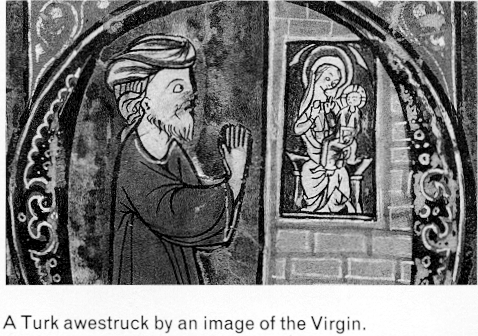
The Madonna on Mount Phileremos, a Byzantine icon [Tempera on wood, 44 x 36 cm], may have been on Rhodes before the Hospital arrived in 1306, and by 1396 at the latest it was an object of popular devotion which worked miracles and was revered by both Latins and Greeks. A magistral bull of 1497 held that it had reached Rhodes miraculously on the waves in the time of an Emperor Leo described as the "Heresiarch", which presumably meant Leo III who had attacked icons in the eighth century. It was mentioned by many travellers and was taken to the city and venerated during the great sieges and at other times of danger; Guillaume Caoursin's publication of 1496 contained a woodcut which showed the Master visiting it during the 1480 siege.
The Phileremos Madonna was considered by the Knights as their most precious possession. It got its name from the sanctuary on Mount Phileremos in Rhodes which was already the centre of a popular cult before the Knights conquered the island in 1306-9. The Rhodians, who venerated it under the title of Qeovtoko" Filevremou~ ('The Mother of God of Phileremos') piously believed that it was painted by St. Luke and brought to Rhodes from Jerusalem about the year 1000. Its fame as a wonder-working image was known all over the Aegean.
Fifteenth century travellers' accounts mention the citadel on Mount Phileremos and report on the icon with its sanctuary and adjoining monastery on which the Knights lavished their munificence. Two new chapels were added to the sanctuary by Grandmaster Pierre d'Aubusson after the siege of 1480 which, according to the eye-witness account of Guillaume Caoursin, had been settled in favour of the Knights by the intercession of the Virgin and St. John the Baptist. During the siege the icon had been transferred for safety inside the walls of the city and the same precaution was adopted in 1513 when there was a threat of an invasion, and in the siege of 1522. On the latter occasion it was placed in the church of St. Mark.
After the loss of Rhodes, the icon followed the Knights on their seven year exile and, between 1524- 27, it was venerated in the collegiate church of SS. Faustino and Giovita at Viterbo. In Malta it was placed in the church of St. Lawrence at Birgu where it escaped damage when the church was destroyed by fire in 1532. After the building of Valletta, it was transferred first to the church of the Virgin of Victories and subsequently to the conventual church when a chapel had been prepared to receive it.
The icon was venerated behind a crystal panel and it had four silver 'dresses' set with pearls and precious stones. After the Napoleonic conquest of Malta in 1798, it was one of the few treasures that Grandmaster Ferdinand von Hompesch was permitted to take out of the island. On 12 October 1799, after the resignation of Hompesch, it was presented, together with the relics of the Hand of the Baptist and a splinter of the True Cross, to Tsar Paul I who had, meanwhile, been elected Grandmaster by a few rebel knights. Though the election was completely irregular, it was accepted in the hope that Paul's influence might regain Malta for the Knights. The presentation was made by the Order's representative, the Count de Litta, in the imperial residence of Gatchina about 40 kilometres outside St. Petersburg.
After Paul's death in 1801, the icon, covered with a gold riza set with precious stones, was transferred to the Winter Palace at St. Petersburg. It survived the Bolshevik revolution of 1917 because, when the palace was stormed, it was in a church at Gatchina, together with the other relies of the Knights, for a celebration in their honour on 12 October. In 1920, after various vicissitudes, the icon and the relics somehow found themselves in the luggage of the dowager empress, Maria Feodorowna, who had sought asylum in her native Denmark. Before she died in 1928, the empress entrusted them to her daughters, the Grand duchesses Xenia Alessandrowna and Olga Alessandrowna, who passed them to the President of the Synod of the Russian Orthodox Bishops in Exile, Archbishop Antoniye of Kieff and Galizia. They were taken to the newly built Russian church in Berlin but, in 1929, they were transferred to Belgrade where in April 1932 they were officially consigned to the custody of Alexander I of Yugoslavia. They were kept in the chapel of the royal palace of Dedinje until 1941 when owing to the threat of the Nazi invasion they were, apparently, sent to the Orthodox Monastery of Ostrog, near Niksic, in Montenegro. Nothing has been heard of them since.
In the early nineteenth century, Tsar Nicholas I commissioned a copy of the icon to be carried in processions and religious manifestation instead of the precious original which was, reputedly, in a precarious condition. This copy has survived and is presently in the Basilica of S. Maria degli Angeli at Assisi. Its degree of faithfulness is unknown, and it has suffered from over painting and an inept restoration but, in the absence of the original, it provides us with the only available indication of the appearance and general characteristics of the icon. It is probable that most of the presumed photographs of the Phileremos Madonna show, in reality, the copy.
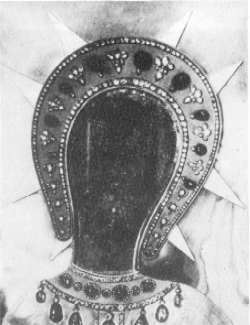
[The 1932 photograph of the true icon]
The only certain photograph of the icon was taken in 1932 when it was entrusted to the custody of the royal family of Yugoslavia. The face of the Virgin appears so blackened that the lineaments can hardly be made out, whereas they are perfectly clear in the other photographs, such as the one published in Sommi-Picenardi 1900. It is not known whether Sommi- Picenardi had access to the icon or to the copy but his description is of interest:
The image of our Lady of Phileremos represents only the face of the Holy Virgin without the Divine Child; the head is slightly inclined on the left shoulder; the face is oval and the nose is very pronounced. The style is entirely Byzantinesque.
He gives the measurements as 44 x 36 cm. The copy measures, on the other hand, 41.2 x 30.3 cm.
The copy arrived in Rhodes in a very damaged state and without the precious riza in 1925 in answer to a request by the Italian Government which, following the occupation of Rhodes in 1912, had undertaken the rebuilding of the Sanctuary on Mount Phileremos. The request had actually been for the true icon but, as its whereabouts were at the time unknown, the copy was sent instead.
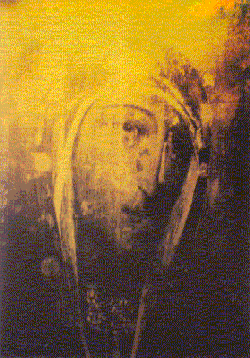
[The Russian copy (without the precious "riza"), before restoration]
A photograph taken before its restoration reveals a work of considerable sophistication. There is a simple sureness of line in the delineation of the features and in the sensitive treatment of the maforion that seems far removed from the stiff and lifeless stylisation of the image today. The restorer, a Turk attached to the Museum of Rhodes, must, in fact, have taken considerable liberties with very damaging results.

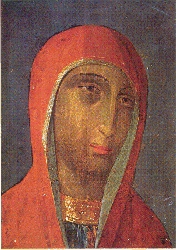
The copy remained in Rhodes until after World War II when, following the annexation of Rhodes to Greece, it was transferred to Italy [in the Basilica of Santa Maria degli Angeli (Porziuncola, Assisi)].
Judging from the copy it appears that the icon originally belonged to a Deesis on the iconostasis of a Byzantine church. In other words, it formed part of a larger composition in which the enthroned, or crucified, Christ was flanked by the Virgin in an attitude of prayer, and by either John the Baptist or John the Evangelist. It showed a bust length portrait of the Virgin wearing a red maforion and a blue, gold-trimmed chiton. The present state of the copy does not permit dating and stylistic considerations.
Bibliography: Sommi-Picenardi 1900; Storace 1984, 981-6; Ferraris di Celle 1988.
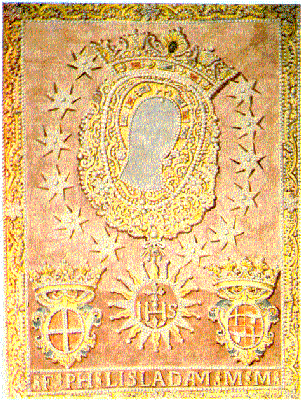
'DRESS' OF THE MADONNA OF PHILEREMOS. Crimson velvet set with pearls and precious stones. 16th century and later. Un vestito di velluto cremesi riccamato con perle con il nome di Gesù in mezzo, et arme della Religione, e dell'Emo disleadamo con alcune pietre preziose come dall'ingionto disegno. Le perle e pietre come dalla stima dietro al disegno ascendono a scudi dieci mila sei cento cinquanta. The inventory describes four 'dresses' of the Phileremos icon the earliest of which was the one with the arms of L'Isle Adam. Oman suggests a seventeenth century date and it is probable that the 'dress' was either re-worked or extensively modified after the Grandmasters death in 1534. Bibliography: Oman 1970
[Pictures and text quoted from: Buhagiar, Mario: Paintings. in: Azzopardi, Canon John (Ed.): The Sovereign Military Hospitaller Order of St. John of Jerusalem of Rhodes and of Malta. The Order's Early Legacy in Malta]
A long-lost icon of the Madonna del Filermo, also known as the 'Madonna of the Knights', has been found in an Orthodox monastery in former Yugoslavia.
The finding of the icon was announced by the new Grand Chancellor of the Sovereign Military Order of Malta, Prince Carlo Marullo in Rome. The Madonna del Fileremo is the protectress of the Mediterranean.
Writing in Il Tempo, Guglielmo de Giovanni Centelles said the icon was lost in a bombing raid in 1941.
The icon, originally brought over to Malta from Rhodes by the Knights, is now being restored in a Marian monastery in Montenegro, famed for its specialised restoration work on icons.
When completely restored in Autumn, the icon will be transferred to the Magistral Palace of the Order in Rome's Via Condotti and, according to the writer, Grandmaster Frà Andrew Bertie will then decide on its final destination.
According to the author, the probable destination would be Fort St. Angelo.
The story behind the icon is of extreme interest. It was discovered in Rhodes by the Knights of St John known as the Knights of Rhodes and then of Malta, while withdrawing from Palestine in 1306.
This very antique icon was preserved in a sanctuary on Mount Phileremou in the midst of thick woods and bed been brought from Jerusalem where, tradition has it, the painting was executed by the Evangelist Luke, together with the "Salus Populi Romani", now in the Basilica of St Mary Major in Rome, the Madonna of St Mary in Via Lata, and those of the Pantheon and the Ara Coeli.
Strongly believed to bear a very close resemblance to the Virgin Mary, this accounts for the outstanding veneration which has accompanied the icon throughout the centuries.
The writer goes on to describe the historical events chronologically. When Rhodes was seized by the Turks in 1523, the Knights went to Malta. The icon was eventually placed in a magnificent chapel on the right hand side of the Cathedral (1578 - 1798).
When Napoleon took over Malta on June 18, 1798, the abdicating Grandmaster von Hompesch took the icon to Trieste together with two important relics of the Order, the arm of St. John and a fragment of the Cross.
The successor, Tsar Paul I secretly embraced Catholicism and transferred the icon to the Winter Palace in St Petersburg.
It stayed there until the Revolution when the Tsarina Mother Maria Féodorovna (Dagmar of Denmark) managed to take it with her into exile in Copenhagen.
Shortly before her death in 1928, the old empress bequeathed the icon to her niece, Yelena Karageorgévitch, daughter of Peter I of Yugoslavia, and of Zorka, of Montenegro.
There is still a delivery note signed by her brother, Alexander I and the Archbishop Antoniye who was expelled from Kieve.
The icon got lost during a bombing raid on the royal palace of Dedinje in 1941, just before the German occupation of Belgrade.
Princess Yelena, from Cannes, in full agreement with her cousin, Queen Elena of Italy, had arranged to have the icon hidden in a monastery in the mountains of Cettigne, "in the midst of people who were very loyal to Petrovitch Niegosch."
The announcement, last Friday, by the Order's Grand Chancellor was made in the course of a meeting at Palazzo Ruspoli in Rome where prominent members of the Roman Nobility were present.
They included Princess Emanuela de Bourbon, Duchess of Segovia, representatives of the patrician Ruspoli, Massimo, Boncompagni. Ludovisi and Pignatelli families whose ancestors had served militarily the great events of the Mediterranean, the sieges of Rhodes and of Malta and the Battle of Lepanto.
[Article in: The Times, Malta, Wednesday, May 28, 1997]
The recovery of the icon of Our Lady of Philermos was reported some time ago and provoked a number of interesting comments. Some new information has now come to light that may be of interest to readers.
As is well known the icon had been held in veneration by the Knights of St John when they settled in Rhodes in 1307. According to tradition, it had been brought to Rhodes by a pilgrim returning from the Holy Land who also built a chapel to the Virgin. In the two sieges of Rhodes it was carried round the walls of the capital and the assistance of the Virgin invoked by the knights.
When the Order came to Malta, the icon was eventually venerated in St. John's cathedral in Valletta. When the island was surrendered to Napoleon in 1798, the icon was stripped of its precious ornaments and followed Hompesch into exile. It was then given to Czar Paul I of Russia, who had been elected Grandmaster of the Order. A precious riza was commissioned for it and it was kept in the chapel in the Imperial palace.
During the Russian revolution of 1917 the icon, which popular tradition attributed to St Luke, was taken out of Russia, and given to the Czarina Maria Feodorovna who kept it till her death. After other vicissitudes it was entrusted by the Russian Orthodox clergy to King Alexander of Yugoslavia, who kept it in Belgrade.
At the time of the German invasion in 1941 it was removed from the capital together with the crown treasures and taken to Montenegro. After that all traces seem to have been lost. It was thought that it had been lost in an air attack on Belgrade, together with other precious relics that had belonged to the Order, including the hand of St John and a relic of the True Cross.
Another version was that it had been placed on a submarine to take it abroad and the submarine had been lost with its precious cargo. Yet another version was that it was deposited in a Swiss bank and could not be withdrawn.
Some year ago, rumours started going round that the icon and the treasure were somewhere in Montenegro. Researchers finally had the confirmation of the Bishop of Montenegro that in fact it was kept in the National Museum and they were allowed to see the icon.
It seems that as the Germans were advancing, the icon was entrusted to a monastery where it was jealously guarded by the monks. During Tito's rule it was moved from one place to another. At one time the police managed to lay hands on it and the other relics and these were taken to Belgrade. It seems, however, that the government eventually decided to return them to Montenegro, in fact to the museum at Cetinje where they were kept in the reserve collection and never exhibited.

[The original icon of Our Lady of Philermos, now in the National Museum of Cetinje, Montenegro]
The icon is in good condition, with both the painting and its precious covering still intact. This is quite surprising considering all it had been through and the poverty of the people in the places where this precious treasure had been preserved. It measures 50 by 37cm and has a rich gold covering which leaves only the face of the Virgin exposed. On the gold covering there is the eight-pointed cross in enamel that radiated round the head of the Virgin. A precious halo surrounds the face, decorated with a row of precious stones and adorned with nine huge rubies alternating with diamonds set in a flower pattern. One of the rubies is missing but it seems it had been missing even when it was handed to King Alexander.
The robe of the Virgin has a neckline with a double tow of diamonds, a necklace of sapphires and diamonds, and hanging from it, six saphires in the shape of drops. The central sapphire is missing and seems to have been replaced with an earring. Surrounding the picture is a gold frame, with winged angels at the corners, and trophies of the Order in the middle.
Now that the icon has been found, a serious iconographic and stylistic study is possible and indeed desirable. This has been impossible till now, as it had only been known through copies.
O.P.
[Article in: The Sunday Times, Malta, April 26, 1998]

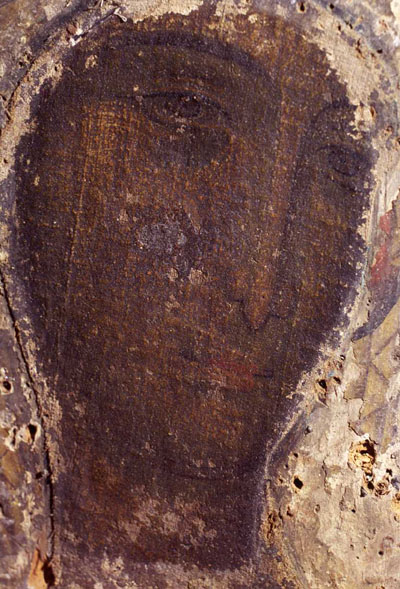

Ambassador Zotov, on your initiative, an international symposium will be held in Valletta on Thursday and Friday on "The Venerable Icon of Our Lady of Philermos in Art, History and Religion".
The icon is one of the most sacred relics of the Knights of Malta. In 1798 it came into the possession of Czar Paul I, Emperor of Russia, who had been proclaimed Protector of the Order and later assumed the Grand Mastership after Bonaparte expelled the knights from Malta. At your invitation, the Russian Metropolitan Kirill, the Montenegrin Metropolitan Amphilohius and high-ranking representatives from the Holy See, together with several other dignitaries, will be coming to Malta to take part in the event.
As initiator of the project, how would you assess its significance?
If we want to comprehend in full what is going to happen in Valletta this week, we should certainly take into account the impending home-coming - after 202 years - of the icon itself, which has not yet been reported in the press. Though, of course, it will be the icon's replica, which, on my request to Metropolitan Kirill and Metropolitan Amphilohius, has been painted specifically by the very best artists in line with ancient technique. Until today, there has been only one copy of the icon made - in 1852 by order of Czar Nicholas I. Both the icon and its copy belonged to the Czar's family. In 1924 it was presented by the Soviet government to Italy as a gift to commemorate the establishment of Soviet-Italian diplomatic relations. Thus, in addition to the so-called 'Russian replica' now housed in Italy, we'll have another one, which I would call 'the Montenegrin copy'. I would wish to suggest that under this name the icon duplicate should enter the history of the religion and of our two nations and remain forever in Malta as a gift from the Orthodox Churches of Russia and Montenegro to the people of Malta and as a token of the unity of our peoples' Christian roots. Having said this, I think the forthcoming events have a tremendous symbolical and moral importance for both Russian-Maltese relations and the entire Christian world.
Is it not momentous enough that this solemn event is taking place immediately after the jubilee of 2000 years of Christianity?
Is it not symbolic that Russian-Maltese relations are starting the 21st century with an event of such a high spiritual standing reflecting the new comprehension of the world, where moral and religious values must be more ardently worshipped and protected, providing us with another impetus to strengthen the centuries-old and deep ties which unite our two countries and peoples?
In organising, last November, the international conference on "Security and Peace in the Mediterranean in the 21st Century: Contributions of Russia and Malta", we wanted to reaffirm our recognition of Malta as a major centre of generating new ideas in this field. Today, in proposing a set of events related to the icon of Our Lady of Philermos, Russia wants to highlight its respect for Malta not only as a nation which earnestly preserves the legacy of many civilisations, cultures and religions, but also as an important ecumenical centre.
If Malta had been destined to be the place where the decision was taken to end the 'cold war' (Gorbachev-Bush Summit in 1989), then is it not an ideal venue for a dialogue between the leaders of the Catholic and the Orthodox Churches, which would pave the way towards their historic and final reconciliation?
Inviting today the representatives of Malta, Russia, Italy, the Holy See and Montenegro to sit at one table, we would like to hope that their joint work will not only once again manifest the importance of religious tolerance and intracultural dialogue for enhancing mutual understanding, but also help the Europeans to better realise the oneness of our religious values, which form the basis of our common Christian civilisation, and see the need for us to stand together in the face of the unprecedentedly large-scale challenge posed by fundamentalists and extremists.
How have the other parties at the symposium responded to this initiative of yours?
Most enthusiastically. The directors of the Russian and the Italian cultural centres, Dr Elizaveta Zolina (my right hand in the project) and Dott. Rosanna Cravenna became the pillars of organisational activities. I have the support of President (Guido) de Marco, the Apostolic Nuncio and Ambassadors of the SMOM and Italy; the Ministry of Education of Malta; the Metropolitan Cathedral Chapter; Mgr Bianco; Mr Galea Naudi, director of the St John's Museum; Mr Achille Mizzi; and Professor Mario Buhagiar of the University of Malta. I am extremely grateful to all of them. My appreciation also goes to Mr Alfred Pisani, a man of great soul and noble heart, who has very kindly invited Metropolitan Kirill to be his guest at the Corinthia Palace Hotel. Quite symbolically, the first meeting of the organising committee, which we have set up to prepare for the symposium, was held on October 25, 2000, the very day that, since 1798, has been celebrated by the Orthodox Church in Russia as the day 'the Maltese relics' (as they are called in the Russian Orthodox Church calendar) were obtained. We saw the blessing of Our Lady in that coincidence. On that day in 1799 (October 12, according to the Julian calendar), together with the other precious relics (the right hand of St John the Baptist and a fragment of the True Cross), the icon was carried in a long coach-procession followed by huge crowds from St Petersburg to Gatchina, the residence of Paul I, where it was exposed in the cathedral for public veneration. Until 1916 the genuine icon and the other relics used to be brought to Gatchina on October 12 every year. The main depository of the 'Maltese relics' was the Grand Cathedral of the Winter Palace in St Petersburg.
And what happened to the icon after 1916?
The original icon was considered lost for a long time. In 1917 the property of the churches of the Imperial Court, including the 'Maltese relics', were transferred to Moscow for safekeeping in the Grand Palace of the Kremlin. The Romanov Family was considered the lawful owner of the relics. In 1919 the relics were transported back to Gatchina and from there taken out of Russia to be given to the Empress Maria Fedorovna, mother of the last Russian Emperor, who returned to Denmark. Just before she died in 1928 she handed them over to a Russian priest in Berlin because she wished them to remain in Orthodox hands. In 1932 the relics were taken to Belgrade where they were consigned to the King of Yugoslavia, Alexander I. In 1941, during the German occupation, the relics disappeared from the Royal Palace. For many years there was no trace of them. Only in 1993 were they taken out of their hiding place.
Is the forthcoming symposium the first attempt ever to study the icon's history?
No. Many historical, religious and cultural traditions of several nations are closely connected with the miraculous icon of Our Lady of Philermo, presumably painted by St Luke. Historians from Russia, Malta and Italy dedicated numerous publications to the historical destiny of the icon in different countries. The most detailed and thorough publication is by Giovanella Ferraris De Celle of Italy. And this is quite logical, since even today the icon brings closer together people of different nations in their veneration of the image of Our Lady, one of the most beautiful examples of early Byzantine art, as well as one of the most miraculous icons of the Christian world.
Why is it "one of the most miraculous icons of the Christian world"?
I did not use the term formally, or canonically speaking. I wanted to stress that the destiny and the role of the icon do definitely attest to its sanctity. At the threshold of the third millennium of the Christian era, it is highly appropriate that we should be making a reappraisal of this holy relic. It has happened many times for a miraculous relic to disappear from public view for years and be considered lost, for it then to be brought back by Providence. This is the case with the 'Maltese relics'. They accompanied the Order of St John in their struggles in Rhodes (1306-1522). They protected the knights in their wanderings in the Mediterranean (1523-30). They helped them to survive in Malta (1530-1798). For almost 120 years the relics were closely connected with the Russian emperors and for decades with the Yugoslav kings. Lately they became associated with the Cetinje monastery in Montenegro, where they are kept today. And here again Providence intervened. It is very symbolical that exactly during the visit of Patriarch of All Russia Alexis II to Yugoslavia in 1993 the icon "reappeared before the world". And it is precisely Russia that has taken the initiative of returning its replica to Malta. The international symposium in Malta is meant to discuss religious, historical and artistic aspects of the icon. And I am sure that as the result of our session the miraculous nature of the relic will once again show and new evidence will emerge to prove that it is truly a bond which unites people. And we all form part of this unity.
Dr Francis Cachia
[ The Times, Malta ]
The webservant of this page received this e-mail on 12 February 2002:
Dear Sirs,
My name is Stevo Vasiljevic, and I'm a photographer for the Montenegrin weekly "Monitor". For this week's issue of our newspaper my journalist colleague Pedja Nikolic and I prepared an article about the icon of Lady of Philerme (Bogorodica Filermosa). While we were searching the Internet for information we found your site and used information from there as a background story about the Our Lady of Philerme icon. Well, I saw on this site that "The only certain photograph of the icon was taken in 1932.." and since we manage to actually get in touch with the icon (and off course take photos) I felt free to send you a few of them. I am sending you a series with
the Icon (01) without glass (mountain crystal) which covers the face of the Madonna,
icon (02) without golden covering but with original black coverage paper which protects the original wooden (painted) parts of the icon
and Icon (03) without any coverage.

There are also macro shoots of places (04,05) of missing jewellery from coverage of Icon.
I'm also pleased to inform you that the relic is in good condition. ... All photos are taken on 11 February 2002 in the historical capital of Montenegro, Cetinje.
Regards from Montenegro
Stevo Vasiljevic
THE ICON OF PANAGHIA TES PHILEREMOU
Rome, 25 February 2002
 For the first time an Italian scholar, Giovannella Bertè Ferraris di Celle, has been allowed to closely observe and photograph the original icon of the Madonna del Fileremo recently found in Montenegro. This scholar has just published a volume entitled "The icon of Panaghia tes Phileremou" on this famous image, about whose real aspect very little has been known until today.
For the first time an Italian scholar, Giovannella Bertè Ferraris di Celle, has been allowed to closely observe and photograph the original icon of the Madonna del Fileremo recently found in Montenegro. This scholar has just published a volume entitled "The icon of Panaghia tes Phileremou" on this famous image, about whose real aspect very little has been known until today.
The writer, who is an expert on the history of the icon due to having carried out research in areas linked to the painting during the 1980's (La Madonna del Fileremo, Giovannella Ferraris di Celle, Verona 1988), went to Montenegro in 1997 on the invitation of the Management of the National Museum, in order to confim that the painting kept there was the famous icon of the Madonna del Fileremo, once kept in Rhodes, then in Malta, in Russia and in Yugoslavia, where it disappeared during World War Two. The authoress was inspired by this first meeting with the precious painting to complete the study from an iconographical point of view as well. To do this, she obtained permission to see the original icon again and photograph it without the golden cover which Tsar Paul I of Russia had given it, and which still protects it today.
The results of the study were the subject matter of the dissertation for her doctorate at the Faculty of Oriental Ecclesiastical Science at the Pontefice Oriental Institute in Rome. The current publication includes the part of the study containing the material and formal description and the aesthetic evaluation of the painting preceded by the history of the icon's movements illustrated by photographic documentation on the present conditions of the painting.
"La Panaghia tes Phileremou" Excerpt from Doctorate Dissertation by Giovannella Bertè Ferraris di Celle, Roma 2001,Ed.Renato Ferraris,
(24x17 cm.;72pp.;Tavv.13 b/n; I.S.B.N.88-900725-9-8; Euro 12,40).
For information on purchases please contact: RENATO FERRARIS EDITORE E-mail: jtvhof@tin.it.
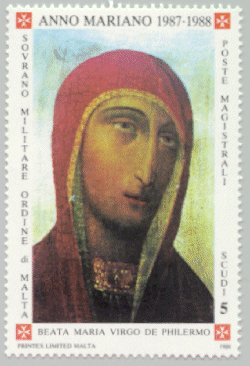

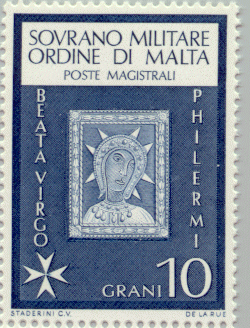
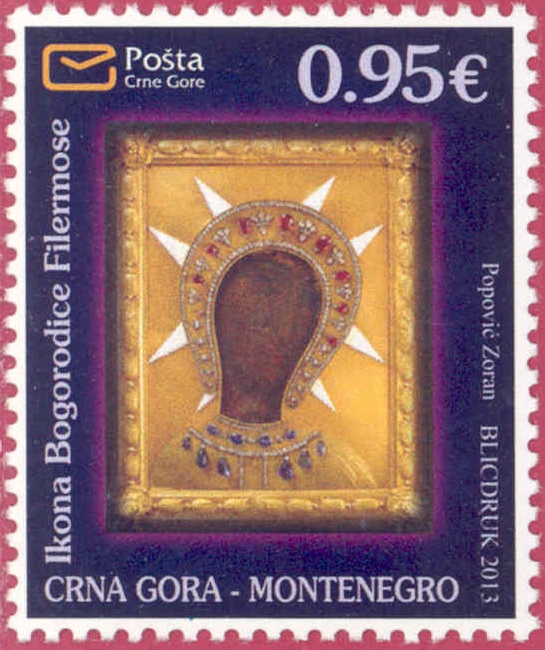
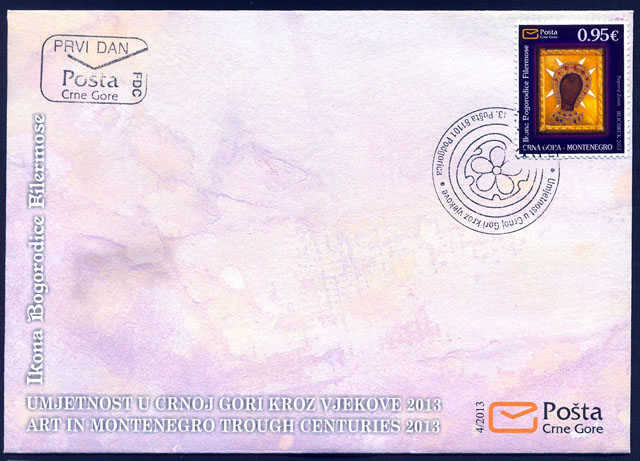
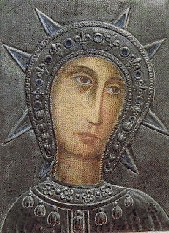

A professed Conventual chaplain of the Order of Malta carrying an icon of Our Lady of Philerme at a procession in St. Pius X basilica in Lourdes on 30 April 2005.

[Our Lady of Philermos, Villa Malta, Aventine, Rome]
Our Lady of Philerme (Stained Glass Window by Guido van Bessouw at Blessed Gérard's Care Centre & Hospice in Mandeni, South Africa)
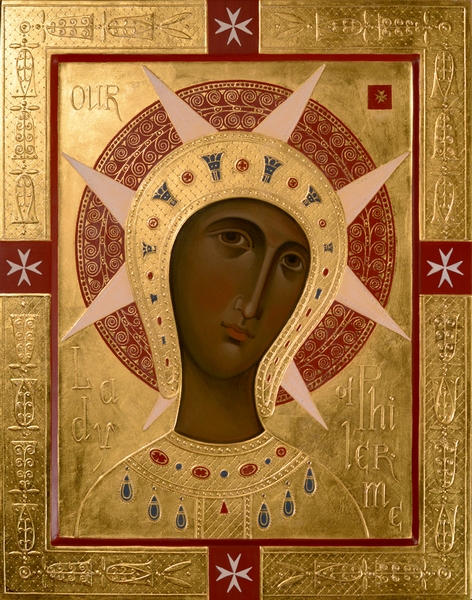
![]()
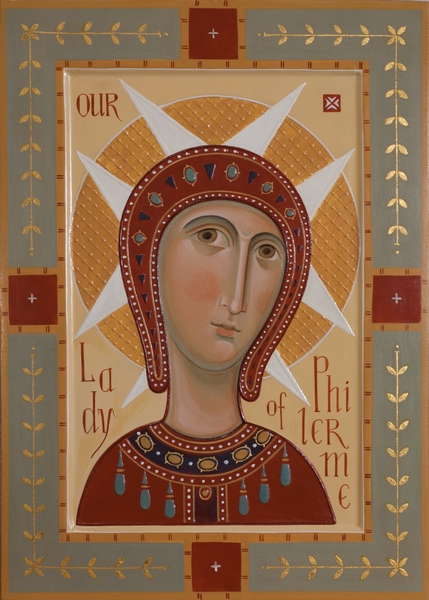
Icons "Holy Virgin Mary of Philermo" handpainted by iconographer Philip Davydov from Sacred Murals Studio of St. Petersburg in Russia
(published with kind permission from the artist - click on the picture for further information)

Malteser-Hospice, Dortmund/Germany


The Our Lady of Philerme Icon at the spiritual centre "Malteserkommende Ehreshoven" in Germany
Artist: Makarius Tauc, Wiesbaden/Germany, 2003, taucicons@aol.com
Pictures from the webservant's visit to Phileremos on 4th August 2015

Filerimos hill (267 m). There is an amazing view from here. The hill took its name from a monk who came from Jerusalem in the 13th century bringing with him an icon of the Blessed Virgin painted by the Apostle Luke. The small church he build became later a basilica and then in the 14th century the Knights built in St. John, a large monastery with its excuisite bell-tower that one still sees today.
Ialyssos & Filerimos [The church built by the Knights, in the 14th c., originally consisted of two hexagonal chapels in the area of the aisleless Byzantine church. It was modified in the late 15th c., though retaining its distinctive double form, since the icon of the Panayia Philerimou was worshipped by both Orthodox and Catholic Christians]
National Museum of Cetinje [where the icon is kept today]
This page was created on 16 June 1998 and last updated on Montag, 22 März 2021 18:38:15
Back to the SMOM Page of the![]()